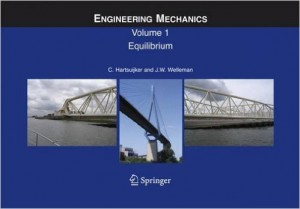Engineering Mechanics Vol 1
Engineering Mechanics Volume 1 Equilibrium by C. Hartsuijker, J.W. Wellemen
Contents of Engineering Mechanics Volume 1
1 Introduction 1
1.1 Mechanics 1
1.2 Quantities, units, dimensions 8
1.3 Vectors 11
1.4 Newton’s Laws 18
2 Statics of a Particle 23
2.1 Coplanar forces 23
2.2 Forces in space 30
2.3 Equilibrium of a particle 35
2.4 Problems 39
3 Statics of a Rigid Body 51
3.1 Coplanar forces and moments 52
3.2 Equilibrium of a rigid body in a plane 71
3.3 Forces and moments in space 80
3.4 Equilibrium of a rigid body in space 93
3.5 Problems 99
4 Structures 111
4.1 Structural elements 113
4.2 Joints between structural elements 116
4.3 Supports 120
4.4 Planar structures 126
4.5 Kinematic/static (in)determinate structures 130
4.6 Problems 145
5 Calculating Support Reactions and Interaction Forces 153
5.1 Self-contained structures 154
5.2 Hinged beams 162
5.3 168
5.4 Three-hinged frames with tie-rod 173
5.5 Shored strucures 176
5.6 Trussed beams 184
5.7 Strengthened beams 186
5.8 Problems 190
6 Loads 205
6.1 Loads in mechanics 206
6.2 Loads in regulations 210
6.3 Working with distributed loads 219
6.4 Modelling load flow 231
6.5 Stress concept; normal stress and shear stress 233
6.6 Problems 236
7 Gas Pressure and Hydrostatic Pressure 245
7.1 Pascal’s law – All-round pressure 246
7.2 Working with gas pressures 248
7.3 Working with hydrostatic pressures 255
7.4 Summary 269
7.5 Problems 271
8 Earth Pressures 285
8.1 Stresses in soil 286
8.2 Vertical earth pressures 288
8.3 Horizontal earth pressures 292
Appendix 8.1 307
Appendix 8.2 308
8.4 Problems 309
9 Trusses 319
9.1 Plane trusses 321
9.2 Kinematically/statically (in)determinate trusses 328
9.3 Determining member forces 337
9.4 Problems 370
10 Section Forces 387
10.1 Force flow in a member 388
10.2 Diagrams for the normal force, shear force and
bending moment 401
10.3 Deformation symbols for shear forces and bending moments 416
10.4 Summary sign conventions for the N, V and M diagrams 420
10.5 Problems 421
11 Mathematical Description of the Relationship between
Section Forces and Loading 431
11.1 Differential equations for the equilibrium 432
11.2 Mathematical elaboration of the relationship between N
and qx (extension) 436
11.3 Mathematical elaboration of the relationship between M,
V and qz (bending) 441
11.4 Problems 456
12 Bending Moment, Shear Force and Normal Force
Diagrams 461
12.1 Rules for drawing V and M diagrams more quickly 462
12.2 Rules for drawing the N diagram more quickly 493
12.3 Bent and compound bar type structures 495
12.4 Principle of superposition 505
12.5 Schematisations and reality 508
12.6 Problems 517
13 Calculating M, V and N Diagrams 545
13.1 Self-contained structures 545
13.2 Compound and associated structures 586
13.3 Statically indeterminate structures 596
13.4 Problems 608
14 Cables, Lines of Force and Structural Shapes 631
14.1 Cables 632
14.2 Centre of force and line of force 674
14.3 Relationship between cable, line of force and structural shape 679
14.4 Problems 694
15 Virtual Work 709
15.1 Work and strain energy 710
ENGINEERING MECHANICS. VOLUME 1: EQUILIBRIUM
downloaded from civilengineerspk.com
Table of Contents vii
15.2 Virtual work equation for a particle 713
15.3 Virtual work equation for a rigid body 719
15.4 Virtual work equation for mechanisms 725
15.5 Calculating forces using virtual work 729
15.6 Problems 739
16 Influence Lines 743
16.1 Influence lines using equilibrium equations 744
16.2 Influence lines using virtual work 748
16.3 Working with influence lines 755
16.4 Problems
Download Engineering Mechanics Vol 1
Engineering Mechanics, Engineering Mechanics, Engineering Mechanics, Engineering Mechanics, Engineering Mechanics, Engineering Mechanics, Engineering Mechanics, Engineering Mechanics, Engineering Mechanics, Engineering Mechanics
